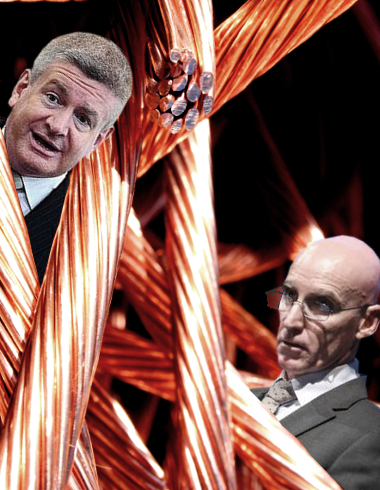Fifield's frail response to Quigley inquisition
 Communications Minister Mitch Fifield has dismissed the detailed analysis of the $15 billion NBN cost blowout by former CEO Mike Quigley, but has not provided any evidence to show why Quigley was incorrect.
Communications Minister Mitch Fifield has dismissed the detailed analysis of the $15 billion NBN cost blowout by former CEO Mike Quigley, but has not provided any evidence to show why Quigley was incorrect.
Quigley’s initial comments came after the NBN company revealed the project’s funding needs had increased by between $5 billion and $15 billion compared with the numbers in the NBN Strategic Review from late 2013.
The big blowout happened after Malcolm Turnbull became Communications Minister, but when it was revealed he said it was because the previous management of the company — led by Mike Quigley as CEO — had been incompetent in its financial modelling.
Quigley took to the airwaves to argue that the cost blowout was in fact due to the Multi-Technology Mix plan for the NBN set up by Turnbull.
Turnbull’s model requires buying back ageing copper and HFC cable networks from Telstra and Optus, to create a technically inferior and rapidly-redundant NBN compared to the near-universal Fibre to the Premises (FTTP) model originally outlined by Labor.
Quigley then went further, putting together and releasing a heavily-detailed document (accessible in PDF form, here) about the financial basis behind his claim.
Current communications Minister Mitch Fifield has now fired back from the Government’s side, dismissing Quigley claims out of hand in a speech at an NBN forum event in Sydney this week.
The full speech is available here.
“I am sure you are aware of the heightened scrutiny of the Corporate Plan and peak funding forecasts over recent weeks,” the Minister said.
“Even critics acknowledge that the multi-technology mix will see fast broadband reach communities sooner and at less cost than the alternatives previously considered.
“Clinging to what might have been in some parallel past takes no account of the billions already spent on the NBN, and indeed, of the revenue foregone given the underperformance of the early years.
“Any reduction in operating costs claimed for an all‐fibre network would be miniscule when compared to just the interest payments on the extra investment required for such construction.
“It is only because of the thorough review process undertaken by the company, as requested by the Government, that we know that the estimated cost of rolling out the network has increased, for both an all-FTTP and multi-technology mix rollout.”
But the Communications Minister did not address the detailed and specific comparisons Quigley made of the five major cost components of the NBN that were in both Labor’s NBN plan and the Coalition’s revised model.
Quigley compared the original costings (under his tenure) of all five elements - FTTP brownfields and greenfields, fixed wireless, satellite and the transit network connecting cities and regions — to the numbers produced by the company under Coalition management (in the November 2013 Strategic Review and the August 2015 Corporate Plan).
For every one of these cases, on raw figures, Quigley showed the NBN company’s estimates had stayed the same over the past few years.
He said it means that the blowout which could top $15 billion disclosed in August was not due to the fact that the rollout model had changed.








 Print
Print